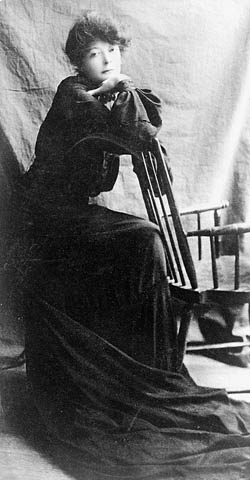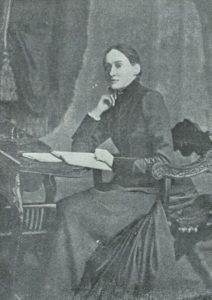“Which is Kit?”: Discovering Kathleen Blake Coleman
By Tara Giddens, University of Limerick

I was first introduced to Kathleen Blake Coleman (1856-1915) by my supervisor when discussing PhD topics. Coleman was an eminent journalist in Canada and the United States at the end of the nineteenth and early twentieth century. She wrote the column “Woman’s Kingdom” for The Toronto Daily Mail, which later became The Daily Mail and Empire, from 1889 to 1911. After leaving the paper, Coleman became a freelancer until her death in 1915. While reading her column, I was drawn into the world of the “Woman’s Kingdom,” and instantly intrigued by Coleman’s voice and her use of both her national identity and gender to attract readers and gain popularity. One of her biggest achievements was becoming the first accredited woman war correspondent in the Spanish-American War in 1898. She was also well-known for her travels, covering the United States, Canada, and Europe as a journalist; even publishing a collection of her articles on Queen Victoria’s Diamond Jubilee in 1897.
However, what makes Coleman so fascinating is how she used both her Irish/British identity to authenticate her international authority and her androgynous pen name “Kit” that allowed her to write on various topics, which were not always common for women, including politics, economics, and other social issues. In my thesis, I write about Coleman’s gender performance through Kit as well as her use of her Irish/United Kingdom heritage in Canada. While Coleman is generally known as a Canadian journalist, I argue that her Irish upbringing (she was born in the west of Ireland and migrated around the age of 28) should not be forgotten as she held on to and used it throughout her career.
Unfortunately, Coleman destroyed most of her letters and personal papers. So, in order to better understand the woman behind the pen name, we must not only look at Coleman’s journalism and public persona Kit, but also the few personal letters that survived, Coleman’s short stories and fiction, and accounts of Coleman’s grandchildren interviewed by journalist and researcher Dr. Barbara Freeman. While attempting to piece together who Coleman was, it is important to differentiate her from the public persona of Kit. This is because Kit did not necessarily represent Coleman’s real beliefs and could either voice more controversial opinions or simultaneously be reserved in other topics, as Kit herself claims she would “much rather sit on a fence …with my feet tucked decorously beneath my skirts, than jump down into the mud and get wet and draggle-tailed and vilified” (Coleman, 28 Feb. 1891, 5). Kit often embellished stories about herself but then created fictional figures or anecdotes that were closer representations of Coleman’s personal life. For example, Kit describes the somewhat sad life of a travelling salesman, his wife, and their two children, which closely resembled Coleman’s second husband Edward Watkins, (whom she had already separated from) and their two children. Yet, these stories give us a glimpse at the real woman behind the column as Coleman hints at her upbringing, personal life, and struggles. Furthermore, it is through the androgynous Kit that Coleman is allowed to cross boundaries in a socially restrictive Canadian/Victorian culture.
Writing under a pen name was not unique for journalists, especially for women journalists who struggled to maintain a respectable social standing and a career. Ruth Y. Jenkins describes how Victorian women “were faced with the twin desires to remain ‘appropriate’ and still enact their ‘inappropriate’ desires” and therefore, “felt compelled to masquerade their intentions or deflect criticism by maintaining a rigorous code of propriety” (17). Using a pseudonym also allowed Coleman the distance to maintain a proper motherly role in society, while still discussing “masculine” topics as Kit. However, that maternal role soon found its way in Coleman’s column as it acted as a protection when voicing the more controversial topics. Her motherly masquerade helped to conciliate both editors and readers, as Freeman explains, “The maternal aspect of the Kit persona was her saving grace in that it blunted the edge of her more forthright characteristics and helped to allay criticism of her as a woman writer. To be a success in journalism, it was necessary for her to attract and hold an audience without threatening their perceptions of women’s proper role” (40). Coleman performed a feminine, maternal role so as not to appear threatening while continuing to discuss current affairs and social issues.
While I explore these issues in more depth in my thesis, using theorists such as Judith Butler and Jack Halberstam, I want to focus more on Kit’s interaction with readers here. Kit moves back and forth between claiming she was a woman and then, usually after getting angry with readers for continuing to question her gender, declares she might as well call herself a man. One reader, known as “Yankee Girl,” claimed she could not figure out if Kit was an old lady, a married woman with numerous children, a young girl, or even a man, saying, “Now, which are you anyway?” (Coleman, 30 May, 1891, 11). To which Kit coyly responds, “Asked with Yankee directness, answered with Irish adaptability. ‘Whichever you like best, my dear’” (Coleman 11).
Another example of a perplexed reader occurred after Kit described going on a fox hunt in Ireland. Near the end of the hunt, the mare Kit was riding refused a jump causing Kit to miss the end of the hunt and, consequently, curse at her horse. A few weeks later, a reader by the name “Resedas” responds to the story arguing that there was no way a woman would have cursed at her horse which proves Kit must be a man, saying, “I think you very talented, but the role you have assumed is rather transparent” (Coleman, 12 April 1890, 5; her emphasis). Kit replies first by declaring “all I can say is I had a good deal more satisfaction in using the forcible language I did than I would have had in calling my horse ‘a nasty horrid beast.’ That may be more womanlike, and ladylike, and proper, but one doesn’t feel very proper and ladylike when one has a sulky, bucking brute of a mare to manage” (Coleman 5). The tone then becomes flirtatious as Kit tells Resedas they are “too smart”. This type of response was common in Coleman’s columns as she seemed to enjoy flirting with some of her readers, when she was either not too annoyed with them, or not taking on a maternal tone.
Even the editor and cartoonist for The Toronto Daily Mail took part by creating a cartoon showing the faces of various people with the title reading “Which is Kit?” (1890) encouraging readers to guess who was behind the name. The uncertainty helped Coleman’s popularity and successes as readers continued to discuss and guess Kit’s gender. Gradually, though, readers seemed to accept that Kit was a woman and she began to call them her “paper children” while her tone became less flirtatious and more maternal. Kit also slowly began mentioning her own children within her column which helped to back the maternal persona. As I said earlier, Coleman had to appease her editors by writing on more feminine topics such as fashion and beauty despite her own desire to write more travel or controversial pieces.

Nevertheless, there are various examples throughout Coleman’s career of her fighting the restrictive social constraints including creating a masculine character, “Autolycus” (a name with connections to Shakespeare) who wrote the section titled “Letters from the Pedlar” in the “Woman’s Kingdom.”. However, as Freeman tells us, this character did not last long due to being too similar to Kit’s voice (90). Another insight into Coleman’s struggle with editors and escaping constraints is found in a poem within the column where the narrator (Coleman) grieves that they are no longer allowed to travel but instead forced to stay inside at their desk, “Ye have tied me down to the desk and the pen. The hurrying pen all day: But my heart is in the tents of the men, Who are roving far away…” (Coleman, 1 Feb. 1896, 5). After the paper merged into the Mail and Empire in 1895, Freeman explains that Coleman “skirmished with the new management … over the contents of her women’s page, with Kit insisting on keeping its intellectual content” (90). Coleman’s struggle with the editors of her paper seemed to have lasted throughout her time there as she was denied equal pay to her male peers and complains about her intense workload. Curiously, according to Freeman, when Coleman became a freelancer, she brought back “the Pedlar” for features in Canada Monthly where she continued to write about politics and crime (150). It is interesting that Coleman dropped the maternal performance once she left the Mail and Empire, but also, that she still felt the need to bring back the masculine persona “The Pedlar” to write about certain contentious or “masculine” topics.
While I am still in the process of researching Coleman’s writing, there is much to be said about her use of gender and voice and how they were perceived by her readers. But it is also important to remember the limitations surrounding Coleman in a much more conservative and restrictive culture. Coleman reshaped traditional gender roles in both her writing and her life. She continues to intrigue and confuse her readers as we attempt to understand her and her writing through more modern theories and analyse who Kit really is. Researching Coleman has been a captivating, enjoyable adventure. That being said, I feel obligated to warn anyone interested in researching Coleman. Her column is like a potato chip, it is not easy to read just one. However, what I can say is, while I might regret eating a whole bag of crisps, I have never regretted spending hours within the “Woman’s Kingdom”.
Works Cited
Coleman, Kathleen. “Woman’s Kingdom.” The Toronto Daily Mail, April 12, 1890, pp.5. Google News Archive
— “Woman’s Kingdom.” The Toronto Daily Mail, 28 Feb., 1891, pp. 5. Google News Archive
— “Woman’s Kingdom.” The Toronto Daily Mail, May 30, 1891, pp 5,11. Google News Archive
Coleman, Kathleen. “Woman’s Kingdom” The Daily Mail and Empire, 1 Feb. 1896, pp 5-6. Google News Archive
Freeman, Barbara M. Kit’s Kingdom: The Journalism of Kathleen Blake Coleman. Carleton UP, 1989.
Jenkins, Ruth Y. “The Gaze of the Victorian Woman Traveler: Spectacles and Phenomena.” Siegel, Kristi, editor. Gender, Genre, & Identity in Women’s Travel Writing. Peter Lang Publishing, Inc., 2011.
Tara Giddens is a PhD candidate with the School of English, Irish, and Communication at the University of Limerick. Tara’s thesis, “Investigating the Irish New Woman: Tracing Journalists in Media and Fiction” compares the Irish New Woman journalist with her fictional counterpart between the 1880s and 1920s. Currently, she is focusing on Irish-Canadian journalist Kathleen “Kit” Coleman who performed her national and gender identity, to maintain readership, in her popular column the “Woman’s Kingdom”.
Tara received her BA in English, with an emphasis in Creative Writing, at Western Washington University, (Bellingham, WA) in 2009. In 2015, she completed her MA in Irish Literature at Maynooth University. After receiving the AHSS (Arts, Humanities and Social Sciences) Faculty PhD Teaching Fellowship in 2016, she started her PhD under the supervision of Dr Tina O’Toole.
Interested in submitting something to our blog? Email Dr Deirdre Flynn.



